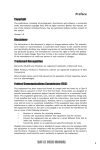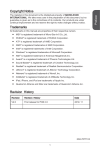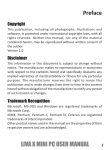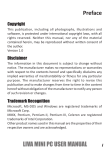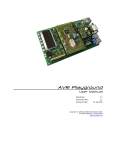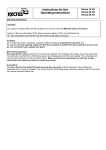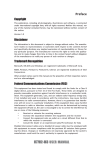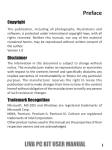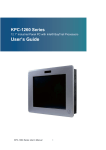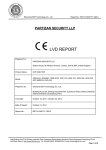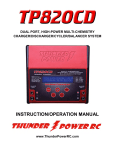Download chapter 1.pmd
Transcript
Preface Copyright This publication, including all photographs, illustrations and software, is protected under international copyright laws, with all rights reserved. Neither this manual, nor any of the material contained herein, may be reproduced without written consent of the author. Version 1.0 Disclaimer The information in this document is subject to change without notice. The manufacturer makes no representations or warranties with respect to the contents hereof and specifically disclaims any implied warranties of merchantability or fitness for any particular purpose. The manufacturer reserves the right to revise this publication and to make changes from time to time in the content hereof without obligation of the manufacturer to notify any person of such revision or changes. Trademark Recognition Microsoft, MS-DOS and Windows are registered trademarks of Microsoft Corp. MMX, Pentium, Pentium-II, Pentium-III, Celeron are registered trademarks of Intel Corporation. Other product names used in this manual are the properties of their respective owners and are acknowledged. Federal Communications Commission (FCC) This equipment has been tested and found to comply with the limits for a Class B digital device, pursuant to Part 15 of the FCC Rules. These limits are designed to provide reasonable protection against harmful interference in a residential installation. This equipment generates, uses, and can radiate radio frequency energy and, if not installed and used in accordance with the instructions, may cause harmful interference to radio communications. However, there is no guarantee that interference will not occur in a particular installation. If this equipment does cause harmful interference to radio or television reception, which can be determined by turning the equipment off and on, the user is encouraged to try to correct the interference by one or more of the following measures: • • • • Reorient or relocate the receiving antenna Increase the separation between the equipment and the receiver Connect the equipment onto an outlet on a circuit different from that to which the receiver is connected Consult the dealer or an experienced radio/TV technician for help Shielded interconnect cables and a shielded AC power cable must be employed with this equipment to ensure compliance with the pertinent RF emission limits governing this device. Changes or modifications not expressly approved by the system’s manufacturer could void the user’s authority to operate the equipment. BAT-TI USER MANUAL Declaration of Conformity This device complies with part 15 of the FCC rules. Operation is subject to the following conditions: • This device may not cause harmful interference. • This device must accept any interference received, including interference that may cause undesired operation. This device is in conformity with the following EC/EMC directives: Limits and methods of mesurement of radio disturbance char EN 55022 acteristics of information technology equipment EN 61000-3-2 Disturbances in supply systems caused EN 61000-3-3 Disturbances in supply systems caused by household appliances and similar electrical equipment “ Voltage fluctuations” EN 55024 Information technology equipment-Immunity characteristicsLimits and methods of measurement Safety for information technology equipment including electrical business equipment EN 60950 CE marking Canadian Department of Communications This class B digital apparatus meets all requirements of the Canadian Interferencecausing Equipment Regulations. Cet appareil numérique de la classe B respecte toutes les exigences du Réglement sur le matériel brouilieur du Canada. About the Manual The manual consists of the following: ii Chapter 1 Introducing the Motherboard Describes features of the motherboard. page 1 Chapter 2 Installing the Motherboard Describes installation of motherboard components. page 7 Chapter 3 Using BIOS Provides information on using the BIOS Setup Utility. page 23 Chapter 4 Describes the motherboard Using the Motherboard Software software. page 43 Chapter 5 Trouble Shooting page 47 Provides basic shooting tips. BAT-TI USER MANUAL trouble TABLE OF CONTENTS Preface i Chapter 1 1 Introducing the Motherboard 1 Introduction...........................................................................................1 Pakage Contents..................................................................................1 Specifications......................................................................................2 Motherboard Components................................................................4 I/O Ports...............................................................................................6 Chapter 2 7 Installing the Motherboard 7 Safety Precautions..............................................................................7 Installing the Motherboard in a Chassis.......................................7 Checking Jumper Settings..................................................................8 Installing Hardware...........................................................................10 Installing Memory Modules.......................................................10 Installing Add-on Cards..........................................................11 Connecting Optional Devices.................................................13 Installing a Hard Disk Drive/Optical Disk Drive........................19 Connecting Case Components........................................................20 Front Panel Header...............................................................................21 Chapter 3 23 Using BIOS 23 About the Setup Utility......................................................................23 The Standard Configuration........................ ...........................23 Entering the Setup Utility.......................................................23 Resetting the Default CMOS Values.....................................24 Using BIOS.........................................................................................24 BIOS Navigation Keys..............................................................25 Main Menu.............................................................................26 Advanced Menu......................................................................27 Chipset Menu..........................................................................35 Feature Menu.............................................................................37 Security Menu.........................................................................38 Boot Menu...............................................................................40 Exit Menu..................................................................................41 Updating the BIOS......................................................................42 BAT-TI USER MANUAL iii Chapter 4 43 Using the Motherboard Software 43 Auto-installing under Windows 8/8.1..............................................43 Running Setup........................................................................43 Manual Installation..........................................................................45 Chapter 5 47 Trouble Shooting 47 Start up problems during assembly..............................................47 Start up problems after prolong use............................................48 Maintenance and care tips..............................................................48 Basic Troubleshooting Flowchart.....................................................49 iv BAT-TI USER MANUAL Introduction Chapter 1 Chapter 1 Introducing the Motherboard Thank you for choosing the BAT-TI motherboard of high performance, enhanced function. This motherboard has Onboard Intel® Bay Trail-D Dual-Core (2C/2T for J1750/ J1800) SoC for high-end business or personal desktop markets. It supports up to 8 GB of system memory with signal channel DDR3 SO-DIMM 1333/ 1066 MHz. One mini PCI Express x1 slot is for extending usage (it supports half-card and you can insert a wireless card into it). It implements an EHCI (Enhanced Host Controller Interface) compliant interface that provides four USB 2.0 ports (two USB 2.0 ports at the rear panel and one USB 2.0 header supports additional two USB 2.0 ports) and two USB 3.0 ports (two USB 3.0 ports at the rear panel). The motherboard is equipped with a full set of I/O ports in the rear panel, including one HDMI_IN port, one HDMI_OUT port, two USB 2.0 ports, two USB 3.0 ports, one RJ45 LAN connector, one DC_IN port, and audio jacks for microphone and line-out. In addition, this motherboard supports two SATA 3.0Gb/s connnectors for expansion. Package Contents Your motherboard package ships with the following items: BAT-TI Motherboard User Manual DVD I/O Shield 1 SATA 3.0Gb/s Cables 1 SATA/Power Cable The package contents above are for reference only, please take the actual package items as standard. BAT-TI USER MANUAL 1 Chapter 1 Specifications • Onboard Intel® Bay Trail-D Dual-Core (2C/2T for J1750/J1800) SoC Intel TDP 10W Memory • • • Signal channel DDR3 SO-DIMM memory architecture 1 x 204-pin DDR3 SO-DIMM socket supports up to 8 GB Supports DDR3 1333/1066 MHz DDR3 SDRAM Expansion Slots • 1 x mini PCI Express x1 slot (supports half-card) Storage • Supported by Intel® Bay Trail-D Dual-Core (2C/2T for J1750/ J1800) SoC - 2 x Serial ATA 3.0Gb/s devices Audio • Realtek ALC662-VD + ALC113GR - 2.1 Channel High Definiton Audio Codec - Compliant with HD Audio specification LAN • Realtek RTL8111G-CG Gigabit LAN - 10/100/1000 Fast Ethernet Controller - Wake-on-LAN and remote wake-up support CPU • Rear Panel I/O • • • • • • • 1 x HDMI_IN port 1 x HDMI_OUT port 2 x USB 2.0 ports 2 x USB 3.0 ports 1 x DC-IN port 1 x RJ45 LAN connector 1 x Audio port (1x Line out, 1x Mic_in) Internal I/O • Connectors & • Headers • • • • • • • • • • • • • 1 x 4-pin CPU_FAN connector 1 x 4-pin SYS_FAN connector 1 x USB 2.0 header supports additional two USB 2.0 ports 2 x Serial SATA 3.0Gb/s connectors 1 x Front Panel audio header 1 x Front Panel switch/LED header 1 x CLR_CMOS jumper 1 x COM header (Optional) 1 x LVDS connector (Optional) 1 x SATA power connector 1 x TXE unlock jumper 1 x Display brightness header (Optional) 1 x Speaker header 1 x Camera header (or can be functioned as a USB2.0 header) 1 x Touch panel header (or can be functioned as a USB2.0 header) 1 x Card reader header (or can be functioned as a USB2.0 header) 1 x CIR header (Optional) 1 x Digital Microphone header (Optional) 1 x LCD select jumper (Optional) • • • • 2 BAT-TI USER MANUAL • AMI BIOS with 64Mb SPI Flash ROM - Supports Plug and Play, STR(S3)/STD(S4) - Supports Hardware Monitor - Supports ACPI 3.0 version & DMI - Supports Audio, LAN, can be disabled in BIOS - Supports Dual-Monitor function - F7 hot key for boot up devices option Form Factor • Thin Mini-ITX Size, 170mm x 170mm BAT-TI USER MANUAL Chapter 1 System BIOS 3 Chapter 1 4 Motherboard Components BAT-TI USER MANUAL LABEL 1. DIMM_1~2 2. CIR 3. BAT1 4. CLR_CMOS 5. SYS_FAN 6. COM 7. LPC_DEBUG 8. TXE_UNLOCK 9. MINI_PCIE 10. CPU_FAN 11. SPEAKER 12. F_AUDIO 13. DMIC 14. TC 15. CM 16. CR 17. F_USB 18. SATA1~2 19. SATA_PWR 20. F_PANEL 21. LCD_SEL 22. LVDS 23. LVDS_BRT COMPONENTS 204-pin DDR3 SDRAM SO-DIMM Consumer Infrared header (optional) Battery Clear CMOS jumper 4-pin system cooling fan connector Onboard serial port header (optional) LPC Debug header—for factory use only TXE Unlock jumper Mini PCI Express x1 slot (supports half-card) 4-pin CPU cooling fan connector Speaker header Front panel audio header Digital Microphone header (optional) 5-pin USB 2.0 header supports one USB 2.0 Device 5-pin USB 2.0 header supports Camera or other USB 2.0 Device 5-pin USB 2.0 header supports Card Reader or other USB 2.0 Device Front panel USB 2.0 header Serial ATA 3.0 Gb/s connectors SATA power connector Front panel switch/LED header LCD select jumper (optional) LVDS connector (optional) Display brightness header (optional) BAT-TI USER MANUAL Chapter 1 Table of Motherboard Components 5 Chapter 1 I/O Ports 1. HDMI_IN Port You can connect the HDMI output of other computer or other HDMI source to the HDMI_IN port. PC HDMI_IN port LCD_MODE button pulse Power ON Un-plugged PC LCD off Power OFF Plugged HDMI LCD off Power ON Plugged PC HDMI LCD off Power OFF Un-plugged LCD off 1. Please press button to switch the mode manually, it will not be automatically switched when inserting the HDMI cable. 2. When HDMI_IN is in use, front panel audio header will be invalid. 2. HDMI_OUT Port You can connect the display device to the HDMI_OUT port. 3. USB 2.0 Ports Use the USB 2.0 ports to connect USB 2.0 devices. 4. USB 3.0 Ports Use the USB 3.0 ports to connect USB 3.0 devices. 5. LAN Port Connect an RJ-45 jack to the LAN port to connect your computer to the Network. Link LED LAN LED Activity LED Link LED Status Description OFF Orange blinking OFF Green No data Active No link Link 6. DC_IN Port Connect the DC_IN port to the power adapter. 7. Line-out(lime) It is used to connect to speakers or headphones. 8. Microphone(pink) It is used to connect to a microphone. 6 BAT-TI USER MANUAL LAN Port Chapter 2 Installing the Motherboard Follow these safety precautions when installing the motherboard: • • • • Wear a grounding strap attached to a grounded device to avoid damage from static electricity. Discharge static electricity by touching the metal case of a safely grounded object before working on the motherboard. Leave components in the static-proof bags. Always remove the AC power by unplugging the power cord from the power outlet before installing or removing the motherboard or other hardware components. Chapter 2 2-1. Safety Precautions 2-2. Installing the motherboard in a Chassis This motherboard carries a Thin Mini-ITX form factor of 170 x 170 mm. Choose a chassis that accommodates this form factor. Make sure that the I/O template in the chassis matches the I/O ports installed on the rear edge of the motherboard. Most system chassis have mounting brackets installed in the chassis, which corresponds to the holes in the motherboard. Place the motherboard over the mounting brackets and secure the motherboard onto the mounting brackets with screws. Do not over-tighten the screws as this can stress the motherboard. BAT-TI USER MANUAL 7 2-3. Checking Jumper Settings The following illustration shows the location of the motherboard jumpers. Pin 1 is labeled. Chapter 2 No. Components 1 LCD_SEL 2 CLR_CMOS 3 TXE_UNLOCK 1. LCD_SEL: LCD Select Jumper (Optional) 1.When your panel connects to LVDS, please check LCD Select header setting first. 2.Due to the differences of the panel parameters, please follow the above illustration to place the jumper caps. 8 BAT-TI USER MANUAL Chapter 2 2. CLR_CMOS: Clear CMOS Jumper To avoid the system instability after clearing CMOS, we recommend users to enter the main BIOS setting page to “Load Default Settings” and then “Save and Exit Setup”. 3. TXE_UNLOCK: TXE Unlock Jumper BAT-TI USER MANUAL 9 2-4. Installing Hardware 2-4-1. Installing Memory Modules • • Chapter 2 • • This motherboard accommodates one memory module. It can support one 204-pin DDR3L DIMM 1333/1066MHz. Do not remove any memory module from its antistatic packaging until you are ready to install it on the motherboard. Handle the modules only by their edges. Do not touch the components or metal parts. Always wear a grounding strap when you handle the modules. You must install one module in the slot. Total memory capacity is 8 GB. Refer to the following to install the memory modules. Install the DIMM module into the slot and press it firmly down until it fits in place. Check that the cutouts on the DIMM module edge connector match the notches in the DIMM slot. DIMM1 10 BAT-TI USER MANUAL 2-4-2. Installing Add-on Cards Chapter 2 The slots on this motherboard are designed to hold expansion cards and connect them to the system bus. Expansion slots are a means of adding or enhancing the motherboard’s features and capabilities. With these efficient facilities, you can increase the motherboard’s capabilities by adding hardware that performs tasks that are not part of the basic system. MINI_PCIE Slot The mini PCI Express x1 slot is for extending usage which supports half-card with USB signal. Before installing an add-on card, check the documentation for the card carefully. If the card is not Plug and Play, you may have to manually configure the card before installation. BAT-TI USER MANUAL 11 Follow these instructions to install an add-on card: Chapter 2 1 Remove a blanking plate from the system case corresponding to the slot you are going to use. 2 Install the edge connector of the add-on card into the expansion slot. Ensure that the edge connector is correctly seated in the slot. 3 Secure the metal bracket of the card to the system case with a screw. For some add-on cards, for example graphics adapters and network adapters, you have to install drivers and software before you can begin using the add-on card. Please refer to the following illustrations to install the add-on card: Insert a WIFI card into the MINI_PCIE Slot. * For reference only 12 BAT-TI USER MANUAL 2-4-3. Connecting Optional Devices Chapter 2 Refer to the following for information on connecting the motherboard’s optional devices: No. Components No. Components 1 TC 7 LVDS_BRT 2 CM 8 CIR 3 CR 9 COM 4 F_USB 10 DMIC 5 SATA1~2 11 F_AUDIO 6 LVDS ~ ~ BAT-TI USER MANUAL 13 1~3. TC/CM/CR: 5-pin USB 2.0 Header supports one USB 2.0 Device/5-pin USB 2.0 Header supports Camera or other USB 2.0 Device/5-pin USB 2.0 Header supports Card Reader or other USB 2.0 Device Chapter 2 4. F_USB: Front Panel USB 2.0 header The motherboard has one USB 2.0 headers supporting two USB 2.0 ports. Additionally, some computer cases have USB ports at the front of the case. If you have this kind of case, use auxiliary USB connector to connect the front-mounted ports to the motherboard. Please make sure that the USB cable has the same pin assignment as indicated above. A different pin assignment may cause damage or system hang-up. 14 BAT-TI USER MANUAL 5. SATA1~2: Serial ATA II Connectors Chapter 2 SATA1~2 connectors are used to support the Serial ATA 3Gb/s device, simpler disk drive cabling and easier PC assembly. It eliminates limitations of the current Parallel ATA interface. But maintains register compatibility and software compatibility with Parallel ATA. 6. LVDS: LVDS Connector (Optional) 1. You can connect the large end of the cable to the LED Panel, and connect the other small end to the slot on the motherboard. 2.Due to the chipset limitation, using dual displays LVDS(AIO) + VGA or LVDS(AIO) + HDMI will cause the problem that you may not enter BIOS setup or have the display problem. BAT-TI USER MANUAL 15 7. LVDS_BRT: LVDS Brightness Control Header (Optional) Chapter 2 8. CIR: Consumer Infrared Header (Optional) 16 BAT-TI USER MANUAL 9. COM: Onboard Serial Port Header (Optional) Chapter 2 Connect a serial port extension bracket to this header to add a serial port to your system. 10. DMIC: Digital Microphone Header (Optional) BAT-TI USER MANUAL 17 11. F_AUDIO: Front Panel Audio Header The front panel audio header allows the user to install auxiliary front-oriented microphone and line-out ports for easier access. This header supports HD audio by default. Chapter 2 18 BAT-TI USER MANUAL 2-4-6. Installing a Hard Disk Drive/Optical Disk Drive This section describes how to install a Hard Disk Drive/Optical Disk Drive. Your motherboard features two SATA connectors supporting a total of two drives. SATA refers to Serial ATA (Advanced Technology Attachment) is the standard interface for the IDE hard drives which are currently used in most PCs. These connectors are well designed and will only fit in one orientation. Locate the SATA connectors on the motherboard and follow the illustration below to install the Hard Disk Drive/Optical Disk Drive. Installing Hard Disk Drive/Optical Disk Drive Chapter 2 About SATA Connectors To install the Hard Disk Drive (HDD)/Optical Disk Drive (ODD), use the HDD/ODD/SATA cables that support the Hard Disk Drive/Optical Disk Drive/Serial ATA protocol. Refer to the illustration below for proper installation: 1 2 3 4 Attach either end of the single SATA cable to the SATA port on the motherboard. Attach the other end of the single SATA cable to the hard disk drive. Attach the linked end of the combo HDD/ODD cable to the Hard Disk Drive/ Optical Disk Drive. Please note that, connect the black cable to the hard disk Drive, then connect the orange cable to the optical disk drive. Attach the other end of the combo HDD/ODD cable to the SATA port and SATA_PWR connector on the motherboard. Please note that, connect the black cable to the SATA_PWR connector, and connect the orange cable to the SATA port. * For reference only BAT-TI USER MANUAL 19 2-4-5. Connecting Case Components After you have installed the motherboard into a case, you can begin connecting the motherboard components. Refer to the following: Chapter 2 No. Components No. Components 1 SATA_PWR 4 CPU_FAN 2 F_PANEL 5 SPEAKER 3 SYS_FAN ~ ~ 1. SATA_PWR: SATA Power Connector 20 BAT-TI USER MANUAL 2. F_PANEL: Front Panel Header Chapter 2 The front panel header (F_PANEL) provides a standard set of switch and LED headers commonly found on ATX or Micro ATX cases. Hard Drive Activity LED Connecting pins 1 and 3 to a front panel mounted LED provides visual indication that data is being read from or written to the hard drive. For the LED to function properly, an IDE drive should be connected to the onboard IDE interface. The LED will also show activity for devices connected to the SCSI (hard drive activity LED) connector. Power/Sleep/Message waiting LED Connecting pins 2 and 4 to a single or dual-color, front panel mounted LED provides power on/off, sleep, and message waiting indication. Reset Switch Supporting the reset function requires connecting pin 5 and 7 to a momentary-contact switch that is normally open. When the switch is closed, the board resets and runs POST. Power Switch Supporting the power on/off function requires connecting pins 6 and 8 to a momentary-contact switch that is normally open. The switch should maintain contact for at least 50 ms to signal the power supply to switch on or off. The time requirement is due to internal de-bounce circuitry. After receiving a power on/off signal, at least two seconds elapses before the power supply recognizes another on/off signal. BAT-TI USER MANUAL 21 3 & 4. SYS_FAN & PWR_FAN: System Cooling FAN Connector & CPU Cooling FAN Connector Connect the system cooling fan cable to SYS_FAN. Connect the CPU cooling fan cable to CPU_FAN. Chapter 2 Users please note that the fan connector supports the CPU cooling fan of 1.1A ~ 2.2A (26.4W max) at +12V. 5. SPEAKER: Internal Speaker Header Connect the case speaker cable to SPEAKER. This concludes Chapter 2. The next chapter covers the BIOS. 22 BAT-TI USER MANUAL Chapter 3 Using BIOS About the Setup Utility The BIOS (Basic Input and Output System) Setup Utility displays the system’s configuration status and provides you with options to set system parameters. The parameters are stored in battery-backed-up CMOS RAM that saves this information when the power is turned off. When the system is turned back on, the system is configured with the values you stored in CMOS. The BIOS Setup Utility enables you to configure: • Hard drives, diskette drives and peripherals • Video display type and display options • Password protection from unauthorized use • Power Management features Chapter 3 The computer uses the latest “American Megatrends Inc. ” BIOS with support for Windows Plug and Play. The CMOS chip on the motherboard contains the ROM setup instructions for configuring the motherboard BIOS. The settings made in the Setup Utility affect how the computer performs. Before using the Setup Utility, ensure that you understand the Setup Utility options. This chapter provides explanations for Setup Utility options. The Standard Configuration A standard configuration has already been set in the Setup Utility. However, we recommend that you read this chapter in case you need to make any changes in the future. This Setup Utility should be used: • when changing the system configuration • when a configuration error is detected and you are prompted to make changes to the Setup Utility • when trying to resolve IRQ conflicts • when making changes to the Power Management configuration • when changing the password or making other changes to the Security Setup Entering the Setup Utility When you power on the system, BIOS enters the Power-On Self Test (POST) routines. POST is a series of built-in diagnostics performed by the BIOS. After the POST routines are completed, the following message appears: Press DEL to enter SETUP BAT-TI USER MANUAL 23 Press the delete key to access BIOS Setup Utility. Aptio Setup Utility - Copyright (C) 2013 American Megatrends, Inc. Main Advanced Chipset Feature Security Boot Exit Choose the system default language. BIOS Information BIOS Version : System Serial Number : Motherboard Serial Number : MAC Address : BTDDW08.112 11/01/2013 00000000 00000000 C8-9C-DC-F2-EE-BB System Language [English] System Date System Time [Fri 11/01/2013] [00:01:55] :Select Screen :Select Item Chapter 3 Enter : Select +/- : Change Opt. F1:General Help F2:Previous Values F3:Optimized Defaults F4:Save & Exit ESC:Exit Version 2.16.1242. Copyright (C) 2013 American Megatrends, Inc. Resetting the Default CMOS Values When powering on for the first time, the POST screen may show a “CMOS Settings Wrong” message. This standard message will appear following a clear CMOS data at factory by the manufacturer. You simply need to Load Default Settings and Save it to reset the default CMOS values. Note: Changes to system hardware such as different CPU, memories, etc. may also trigger this message. Using BIOS When you start the Setup Utility, the main menu appears. The main menu of the Setup Utility displays a list of the options that are available. A highlight indicates which option is currently selected. Use the cursor arrow keys to move the highlight to other options. When an option is highlighted, execute the option by pressing <Enter>. Some options lead to pop-up dialog boxes that prompt you to verify that you wish to execute that option. Other options lead to dialog boxes that prompt you for information. Some options (marked with a triangle ) lead to submenus that enable you to change the values for the option. Use the cursor arrow keys to scroll through the items in the submenu. 24 BAT-TI USER MANUAL In this manual, default values are enclosed in parenthesis. Submenu items are denoted by a triangle . The default BIOS setting for this motherboard apply for most conditions with optimum performance. We do not suggest users change the default values in the BIOS setup and take no responsibility to any damage caused by changing the BIOS settings. BIOS Navigation Keys The BIOS navigation keys are listed below: KEY +/Enter FUNCTION Exits the current menu Scrolls through the items on a menu Change Opt. Select F1 General Help F2 Previous Value F3 Optimized Defaults F4 Save & Exit Chapter 3 ESC For the purpose of better product maintenance, the manufacture reserves the right to change the BIOS items presented in this manual. The BIOS setup screens shown in this chapter are for reference only and may differ from the actual BIOS. Please visit the manufacture’s website for updated manual. BAT-TI USER MANUAL 25 Main Menu When you enter the BIOS Setup program, the main menu appears, giving you an overview of the basic system information. Select an item and press <Enter> to display the submenu. Aptio Setup Utility - Copyright (C) 2013 American Megatrends, Inc. Main Advanced Chipset Feature Security Boot Exit Choose the system default language. BIOS Information BIOS Version : System Serial Number : Motherboard Serial Number : MAC Address : BTDDW08.112 11/01/2013 00000000 00000000 C8-9C-DC-F2-EE-BB Chapter 3 System Language [English] System Date System Time [Fri 11/01/2013] [00:01:55] :Select Screen :Select Item Enter : Select +/- : Change Opt. F1:General Help F2:Previous Values F3:Optimized Defaults F4:Save & Exit ESC:Exit Version 2.16.1242. Copyright (C) 2013 American Megatrends, Inc. BIOS Version (BTDDW08.112 11/01/2013) This item shows the information of the BIOS version. System Serial Number (00000000) This item shows the information of the system serial number. Motherboard Serial Number (00000000) This item shows the information of the motherboard serial number. MAC Address (C8-9C-DC-F2-EE-BB) This item shows the information of the MAC address. System Language (English) This item is used to set system language. System Date & Time The Date and Time items show the current date and time on the computer. If you are running a Windows OS, these items are automatically updated whenever you make changes to the Windows Date and Time Properties utility. 26 BAT-TI USER MANUAL Advanced Menu The Advanced menu items allow you to change the settings for the CPU and other system. Aptio Setup Utility - Copyright (C) 2013 American Megatrends, Inc. Advanced Chipset Feature Security Boot Exit LAN Configuration Power Management Setup PC Health Status ACPI Settings CPU Configuration SATA Configuration LAN Configuration Parameters :Select Screen :Select Item Enter : Select +/- : Change Opt. F1:General Help F2:Previous Values F3:Optimized Defaults F4:Save & Exit ESC:Exit Version 2.16.1242. Copyright (C) 2013 American Megatrends, Inc. BAT-TI USER MANUAL Chapter 3 Main 27 LAN Configuration The item in the menu shows the LAN-related information that the BIOS automatically detects. Aptio Setup Utility - Copyright (C) 2013 American Megatrends, Inc. Main Advanced Chipset Feature Security Boot Exit Enabled/Disabled UEFI Network Stack LAN Configuration Onboard LAN Controller [Enabled] Network Stack Ipv4 PXE Support Ipv6 PXE Support [Enabled] [Enabled] [Enabled] :Select Screen :Select Item Chapter 3 Enter : Select +/- : Change Opt. F1:General Help F2:Previous Values F3:Optimized Defaults F4:Save & Exit ESC:Exit Version 2.16.1242. Copyright (C) 2013 American Megatrends, Inc. Onboard LAN Controller (Enabled) Use this item to enable or disable Onboard LAN 1 controller. Network Stack (Enabled) Use this item to enable or disable UEFI network stack. Ipv4/6 PXE Support (Enabled)* Use these items to enable or disable Ipv4/6 PXE Boot Support. If disabled Ipv4/6 PXE, boot option will not be created. *These two items will be hidden when Network Stack is set to be disabled. Press <Esc> to return to the Advanced Menu page. 28 BAT-TI USER MANUAL Power Management Setup This page sets up some parameters for system power management operation. Main Aptio Setup Utility - Copyright (C) 2013 American Megatrends, Inc. Advanced Chipset Feature Security Boot Exit Power Management Setup Resume By PME EUP Function About Resume by PCI/PCI-E/LAN/Ext .USB3.0 PME [Enabled] [Enabled] Enter : Select +/- : Change Opt. F1:General Help F2:Previous Values F3:Optimized Defaults F4:Save & Exit ESC:Exit Version 2. 16.1242. Copyright (C) 2013 American Megatrends, Inc. Resume By PME (Disabled) This item specify whether the system will be awakened from power saving modes when activity or input signal of the specified hardware peripheral or components is detected. Chapter 3 :Select Screen :Select Item EUP Function (Enabled) This item allows user to enable or disable EUP support. Press <Esc> to return to the Advanced Menu page. BAT-TI USER MANUAL 29 PC Health Status On motherboards support hardware monitoring, this item lets you monitor the parameters for critical voltages, temperatures and fan speeds. Aptio Setup Utility - Copyright (C) 2013 American Megatrends, Inc. Main Advanced Chipset Feature Security Boot Exit PC Health Status CPU Temperature System Temperature CPU Fan Speed System Fan Speed CPU Voltage DIMM Voltage +12V 42O C 40O C 1630 RPM 1377 RPM 0.816V 1.356V 12.168V :Select Screen :Select Item Chapter 3 Enter : Select +/- : Change Opt. F1:General Help F2:Previous Values F3:Optimized Defaults F4:Save & Exit ESC:Exit Version 2.16.1242. Copyright (C) 2013 American Megatrends, Inc. System Component Characteristics These items display the monitoring of the overall inboard hardware health events, such as System temperature, CPU & DIMM voltage, CPU & System fan speed... etc. • • • • • • • CPU Temperature System Temperature CPU Fan Speed System Fan Speed CPU Voltage DIMM Voltage +12V Press <Esc> to return to the Advanced Menu page. 30 BAT-TI USER MANUAL ACPI Configuration The item in the menu shows the highest ACPI sleep state when the system enters suspend. Main Aptio Setup Utility - Copyright (C) 2013 American Megatrends, Inc. Advanced Chipset Feature Security Boot Exit ACPI Settings ACPI Sleep State [S3 (Suspend to RAM)] Select the highest ACPI sleep state the system will enter when the SUSPEND button is pressed. Enter : Select +/- : Change Opt. F1:General Help F2:Previous Values F3:Optimized Defaults F4:Save & Exit ESC:Exit Version 2.16.1242. Copyright (C) 2013 American Megatrends, Inc. Chapter 3 :Select Screen :Select Item ACPI Sleep State [S3(Suspend to RAM)] This item allows user to enter the ACPI S3 (Suspend to RAM) Sleep State (default). Press <Esc> to return to the Advanced Menu page. BAT-TI USER MANUAL 31 CPU Configuration The item in the menu shows the CPU Configuration. Main Aptio Setup Utility - Copyright (C) 2013 American Megatrends, Inc. Advanced Chipset Feature Security Boot Exit Socket sepcific CPU Information CPU Configuration Socket 0 CPU Information Chapter 3 CPU Speed 64-bit 2001 MHz Supported :Select Screen :Select Item Limit CPUID Maximum Execute Disable Bit Hardware Prefetcher Adjacent Cache Line Prefetch Intel Virtualization Technology Power Technology Enhanced Halt (ClE) [Disabled] [Enabled] [Enabled] [Enabled] [Enabled] [Energy Efficient] [Enabled] Enter : Select +/- : Change Opt. F1:General Help F2:Previous Values F3:Optimized Defaults F4:Save & Exit ESC:Exit Version 2.16.1242. Copyright (C) 2013 American Megatrends, Inc. Socket 0 CPU Information Scroll to this item and press <Enter> and view the following screen: Main Aptio Setup Utility - Copyright (C) 2013 American Megatrends, Inc. Advanced Chipset Feature Security Boot Exit Socket 0 CPU Information Socket sepcific CPU Information Intel(R) Celeron(R) CPU J1850 @ 1.99GHz CPU Signature 30673 Microcode Patch 312 Max CPU Speed 1990 MHz Min CPU Speed 500 MHz Processor Cores 4 Intel HT Technology Not Supported Intel VT-x Technology Supported :Select Screen :Select Item L1 Data Cache L1 Code Cache L2 Cache L3 Cache 24 KB x 4 32 KB x 4 1024 KB x 2 Not Present Enter : Select +/- : Change Opt. F1:General Help F2:Previous Values F3:Optimized Defaults F4:Save & Exit ESC:Exit Version 2.16.1242. Copyright (C) 2013 American Megatrends, Inc. Intel(R) Celeron(R) CPU J1850 @ 1.99GHz This is display-only field and diaplays the information of the CPU installed in your computer. CPU Signature (30673) This item shows the information of the CPU signature. Microcode Patch (312) This item shows the version of microcode patch. Max CPU Speed (1990 MHz) This item shows the max speed of the CPU. Min CPU Speed (500 MHz) This item shows the min speed of the CPU. 32 BAT-TI USER MANUAL Processor Cores (4) This item shows the number of cores of the processor. Intel HT Technology (Not Supported) This item shows the computer supports Intel HT technology or not. Intel VT-X Technology (Supported) This item shows the computer supports Intel VT-X technology or not. L1 Data Cache (24 KB x 4) This item shows the size of CPU L1 Data Cache memory. L2/L3 Cache (1024 KB x 2/Not Present) These items show the size of CPU L2/L3 Cache memory. Press <Esc> to return to the CPU Configuration page. CPU Speed (2001 MHz) This item shows the processor speed. Chapter 3 L1 Code Cache (32 KB x 4) This item shows the size of CPU L1 Code Cache memory. 64-bit (Supported) This item shows the computer supports EMT64. Limit CPUID Maximum (Disabled) Use this item to enable or disable the maximum CPUID value limit, you can enable this item to prevent the system from “rebooting” when trying to install Windows NT 4.0. Excute Disable Bit (Enabled) This item allows the processor to classify areas in memory by where application code can execute and where it cannot. When a malicious worm attempts to insert code in the buffer, the processor disables code execution, preventing damage or worm propagation. Replacing older computers with Execute Disable Bit enabled systems can halt worm attacks, reducing the need for virus related repair. Hardware Prefetcher (Enabled) This item enables or disables hardware prefetcher. Adjacent Cache Line Prefetch (Enabled) This item enables or disables adjacent cache line prefetch. Intel Virtualization Technology (Enabled) When disabled, a VMM cannot utilize the additional hardware capabilities provided by Vandor Pool Technology. Power Technology (Energy Efficient) Use this item to control the Energy mode of the processor. Enhanced Halt (ClE) (Enabled) Use this item to enable the CPU energy-saving function when the system is not running. Press <Esc> to return to the Advanced Menu page. BAT-TI USER MANUAL 33 SATA Configuration Use this item to show the mode of serial SATA configuration options. Aptio Setup Utility - Copyright (C) 2013 American Megatrends, Inc. Main Advanced Chipset Feature Security Boot Exit Select IDE / AHCI SATA Configuration SATA Mode [AHCI Mode] SATAII Port1 SATAII Port2 INTEL SSDSC2CW (60.0GB Not Present :Select Screen :Select Item Chapter 3 Enter : Select +/- : Change Opt. F1:General Help F2:Previous Values F3:Optimized Defaults F4:Save & Exit ESC:Exit Version 2.16.1242. Copyright (C) 2013 American Megatrends, Inc. SATA Mode (AHCI Mode) Use this item to select SATA mode. SATA Port1~2 (INTEL SSDSC2CW (60.0GB/Not Present) This motherboard supports two SATA channels, each channel allows one SATA device to be installed. Use these items to configure each device on the SATA channel. Press <Esc> to return to the Advanced Menu page. 34 BAT-TI USER MANUAL Chipset Menu The chipset menu items allow you to change the settings for the SoC chip and other system. Main Aptio Setup Utility - Copyright (C) 2013 American Megatrends, Inc. Advanced Chipset Feature Security Boot Exit SoC Parameters Soc Configuration TXE Configuration Enter : Select +/- : Change Opt. F1:General Help F2:Previous Values F3:Optimized Defaults F4:Save & Exit ESC:Exit Version 2.16.1242. Copyright (C) 2013 American Megatrends, Inc. Chapter 3 :Select Screen :Select Item SoC Configuration Scroll to this item and press <Enter> and view the following screen: Main Aptio Setup Utility - Copyright (C) 2013 American Megatrends, Inc. Advanced Chipset Feature Security Boot Exit SoC Configuration DVMT Pre-Allocated DVMT Total Gfx Mem [32M] [256M] Restore AC Power Loss [Power Off] Audio Configuration Azalia HD Audio Azalia Internal HDMI Codec [Enabled] [Enabled] Select DVMT 5.0 Pre-Allocated (Fixed) Graphics Memory size used by the Internal Graphics Device. :Select Screen :Select Item Enter : Select +/- : Change Opt. F1:General Help F2:Previous Values F3:Optimized Defaults F4:Save & Exit ESC:Exit Version 2.16.1242. Copyright (C) 2013 American Megatrends, Inc. DVMT Pre-Allocated (32M) This item is used to select DVMT 5.0 Pre-Allocated (Fixed) Graphics Memory size used by the Internal Graphics Device. DVMT Total Gfx Mem (256M) This item shows the information of DVMT 5.0 and graphic memory size used by Internal Graphics Device. Restore AC Power Loss (Power Off) This item enables your computer to automatically restart or return to its operating status. Azalia HD Audio (Enabled) This item enables or disables Azalia HD Audio. BAT-TI USER MANUAL 35 Azalia Internal HDMI Codec (Enabled) This item enables or disables Azalia Internal HDMI Codec. Press <Esc> to return to the Chipset Menu page. TXE Information Scroll to this item and press <Enter> and view the following screen: Chapter 3 Main Aptio Setup Utility - Copyright (C) 2013 American Megatrends, Inc. Advanced Chipset Feature Security Boot Exit TXE Information Sec RC Version TXE FW Version 00.05.00.00 01.00.02.1060 :Select Screen :Select Item Enter : Select +/- : Change Opt. F1:General Help F2:Previous Values F3:Optimized Defaults F4:Save & Exit ESC:Exit Version 2.16.1242. Copyright (C) 2013 American Megatrends, Inc. Sec RC Version (00.05.00.00) This item shows the Sec Reference Code Version. TXE FW Version (01.00.02.1060) This item shows the TXE Firmware Version. 36 BAT-TI USER MANUAL Feature Menu This page displays the information of feature of the motherboard. Main Aptio Setup Utility - Copyright (C) 2013 American Megatrends, Inc. Advanced Chipset Feature Security Boot Exit Enable/Disable Intel SpeedStep Intel Advance Feature Enhanced Intel SpeedStep Technology [Enabled] Enter : Select +/- : Change Opt. F1:General Help F2:Previous Values F3:Optimized Defaults F4:Save & Exit ESC:Exit Version 2.16.1242. Copyright (C) 2013 American Megatrends, Inc. Chapter 3 :Select Screen :Select Item Enhanced Intel SpeedStep Technology (Enabled) This item allows users to enable or disable the EIST (Enhanced Intel SpeedStep Technology). BAT-TI USER MANUAL 37 Security Menu This page enables you to set setup administrator password and user password. Main Aptio Setup Utility - Copyright (C) 2013 American Megatrends, Inc. Advanced Chipset Feature Security Boot Exit Administrator Password Status User Password Status Not Installed Not Installed Set Administrator Password. The password must be 3 to 20 characters long. Administrator Password :Select Screen :Select Item Secure Boot menu Chapter 3 Enter : Select +/- : Change Opt. F1:General Help F2:Previous Values F3:Optimized Defaults F4:Save & Exit ESC:Exit Version 2.16.1242. Copyright (C) 2013 American Megatrends, Inc. Administrator Password Status (Not Installed) This item shows administrator password installed or not. User Password Status (Not Installed) This item shows user password installed or not. Secure Boot menu Scroll to this item and press <Enter> and view the following screen: Main Aptio Setup Utility - Copyright (C) 2013 American Megatrends, Inc. Advanced Chipset Feature Security Boot Exit System Mode Secure Boot Secure Boot Secure Boot Mode Key Management User Active [Enabled] [Standard] Secure Boot can be enabled if 1. System running in User mode with enrolled Platform Key(PK) 2. CSM function is disabled :Select Screen :Select Item Enter : Select +/- : Change Opt. F1:General Help F2:Previous Values F3:Optimized Defaults F4:Save & Exit ESC:Exit Version 2.16.1242. Copyright (C) 2013 American Megatrends, Inc. System Mode (User) This item shows system of secure boot (can be setup or user). Secure Boot (Active/Enabled) This item shows the active state of secure boot. Secure Boot Mode (Standard) This item is used to select secure boot mode, when you select standard mode, secure boot policy is fixed; when you select custom mode, the image execution policy and secure boot key databases are changeable. 38 BAT-TI USER MANUAL Key Management Scroll to this item and press <Enter> and view the following screen: Main Aptio Setup Utility - Copyright (C) 2013 American Megatrends, Inc. Advanced Chipset Feature Security Boot Exit Default Key Provision [Enabled] Enroll All Factory Default Keys Save All Secure Boot Variables Platform Key (PK) Install Factory default Secure Boot Keys when System is in Setup Mode. INSTALLED Key Exchange Key (KEK) INSTALLED Authorized Signatures INSTALLED Delete KEK Set new KEK Append KEK Delete DB Set new DB Append DB Forbidden Signatures Delete DBX Set new DBX Append DBX INSTALLED :Select Screen :Select Item Enter : Select +/- : Change Opt. F1:General Help F2:Previous Values F3:Optimized Defaults F4:Save & Exit ESC:Exit Chapter 3 Delete PK Set new PK Version 2.16.1242. Copyright (C) 2013 American Megatrends, Inc. Default Key Provision (Enabled) Use this item to install default secure boot keys when system is in setup mode. Enroll All Factory Default Keys Use this item to force system to user mode--install all factory default keys (PK, KEK, DB, DBX). And the change takes effect after reboot. Save All Secure Boot Variables Use this item to store content of each secure boot variable (data formatted as EFI_SIGNATURE_LIST) to a file with matching name on selected file system’s root folder. Platform Key (PK) (INSTALLED) This item shows the information of the platform key. Delete PK/KEK/DB/DBX These items are used to delete the variable. Set new PK/KEK/DB/DBX These items launche the file brower to set Efi Variable from the fiel. The file data must be formatted as Efi Variable with TimeBased Authenticated Header. Key Exchange Key (KEK)/Authorized Signatures/Forbidden Signatures (INSTALLED) These items shows the Key Exchange key (KEK)/Authorized Signatures/Forbidden Signature installed or not. Append KEK/DB/DBX These items launche the file brower to append new signature database from the fiel. The file data must be formatted as Efi Variable with TimeBased Authenticated Header. BAT-TI USER MANUAL 39 Boot Menu This page enables you to set the keyboard NumLock state. Aptio Setup Utility - Copyright (C) 2013 American Megatrends, Inc. Main Advanced Chipset Feature Security Boot Exit Boot Configuration Chapter 3 Fast Boot VGA Support USB Support Network Stack Driver Support [Enabled] [EFI Driver] [Partial Initial] [Disabled] Bootup NumLock State Quiet Boot [On] [Enabled] Set Boot Priority Boot Option #1 Boot Option #2 Boot Option #3 Boot Option #4 Boot Option #5 Boot Option #6 [USB Flash] [CD/DVD] [Hard Disk: Windows...] [USB CD/DVD] [USB Hard Disk] [Network] UEFI Hard Disk Drive Priorities Enables or disables boot with initialization of a minimal set of devices required to launch active boot option. Has no effect for BBS boot options. :Select Screen :Select Item Enter : Select +/- : Change Opt. F1:General Help F2:Previous Values F3:Optimized Defaults F4:Save & Exit ESC:Exit Version 2.16.1242. Copyright (C) 2013 American Megatrends, Inc. Fast Boot (Enabled) Use this item to enable or disable the fast boot. VGA Support (EFI Driver) If auto, only install legacy OpROM with legacy OS and Post logo will not be shown during post. EFI driver still be installed with EFI OS. USB Support (Partial Initial) If you select Disabled, all USB devices will not be available until after OS boot. If you select Partial Initial, specific USB port/device will not be available before OS boot. If you select Full Initial, all USB devices will be available in OS and POST. Network Stack Driver Support (Disabled) If disabled, Network stack driver will be skipped. Bootup NumLock State (On) This item enables you to select NumLock state. Quiet Boot (Enabled) Use this item to enable or disable the Quiet boot. Set Boot Priority This item enables you to set boot priority for all boot devices. Boot Option #1 /2 /3 /4 /5 /6 /7 These items show the boot priorities. UEFI Hard Disk Drive Priorities This item enables you to specify the sequence of loading the operating system. Press <Enter> to see the submenu. 40 BAT-TI USER MANUAL Exit Menu This page enables you to exit system setup after saving or without saving the changes. Aptio Setup Utility - Copyright (C) 2013 American Megatrends, Inc. Advanced Chipset Feature Security Boot Exit Save Changes and Exit Discard Changes and Exit Save Changes and Reset Discard Changes and Reset Save Options Save Changes Discard Changes Restore Defaults Save as User Defaults Restore User Defaults Exit system setup after saving the changes. :Select Screen :Select Item Enter : Select +/- : Change Opt. F1:General Help F2:Previous Values F3:Optimized Defaults F4:Save & Exit ESC:Exit Chapter 3 Main Version 2.16.1242. Copyright (C) 2013 American Megatrends, Inc. Save Changes and Exit This item enables you to exit system setup after saving the changes. Discard Changes and Exit This item enables you to exit system setup without saving any changes. Save Changes and Reset This item enables you to reset system setup after saving the changes. Discard Changes and Reset This item enables you to reset system setup without saving any changes. Save Options This item enables you to save the options that you have made. Save Changes This item enables you to save the changes that you have made. Discard Changes This item enables you to discard any changes that you have made. Restore Defaults This item enables you to restore the system defaults. Save as User Defaults This item enables you to save the changes that you have made as user defaults. Restore User Defaults This item enables you to restore the user defaults. BAT-TI USER MANUAL 41 Updating the BIOS You can download and install updated BIOS for this motherboard from the manufacturer’s Website. New BIOS provides support for new peripherals, improvements in performance, or fixes for known bugs. Install new BIOS as follows: Chapter 3 1 If your motherboard has a BIOS protection jumper, change the setting to allow BIOS flashing. 2 If your motherboard has an item called Firmware Write Protect in Advanced BIOS features, disable it. (Firmware Write Protect prevents BIOS from being overwritten.) 3 Prepare a bootable device or create a bootable system disk. (Refer to Windows online help for information on creating a bootable system disk.) 4 Download the Flash Utility and new BIOS file from the manufacturer’s Web site. Copy these files to the bootable device. 5 Turn off your computer and insert the bootable device in your computer. (You might need to run the Setup Utility and change the boot priority items on the Advanced BIOS Features Setup page, to force your computer to boot from the bootable device first.) 6 At the C:\ or A:\ prompt, type the Flash Utility program name and the file name of the new BIOS and then press <Enter>. Example: AFUDOS.EXE 040706.ROM 7 When the installation is complete, remove the bootable device from the computer and restart your computer. If your motherboard has a Flash BIOS jumper, reset the jumper to protect the newly installed BIOS from being overwritten. The computer will restart automatically. This concludes Chapter 3. Refer to the next chapter for information on the software supplied with the motherboard. 42 BAT-TI USER MANUAL Chapter 4 Using the Motherboard Software Auto-installing under Windows 8/8.1 The auto-install DVD-ROM makes it easy for you to install the drivers and software. The support software DVD-ROM disc loads automatically under Windows 8/8.1. When you insert the DVD-ROM disc in the DVD-ROM drive, the auto-run feature will automatically bring up the installation screen. The screen has four buttons on it: Setup, Utilities, Browse CD and Exit. Click “Exit” button to close the Auto-Setup window. Browse CD: Open Windows Explorer and show the contents of the support disk. Click the “Setup” button to select and run the software installation program. Chapter 4 Information: Displays the path for all software and drivers available on the disk. Click the “ Utilities” button to select and install the Intelligent Utility. Running Setup Follow these instructions to install device drivers and software for the motherboard: 1. Click Setup. The installation program begins: The following screens are examples only. The screens and driver lists will be different according to the motherboard you are installing. The motherboard identification is located in the upper left-hand corner. BAT-TI USER MANUAL 43 Click Next. The following screen appears: 3. Check the box next to the items you want to install. The default options are recommended. 4. Click Next to run the Installation Wizard. An item installation screen appears: 5. Follow the instructions on the screen to install the items. Chapter 4 2. Drivers and software are automatically installed in sequence. Follow the onscreen instructions, confirm commands and allow the computer to restart a few times to complete the installation. Windows 8 will show the following screen after system restart, you must select “Desktop” in the bottom left to install the next driver. 44 BAT-TI USER MANUAL Manual Installation Chapter 4 Windows 8/8.1 will appear below UAC (User Account Control) message after the system restart. You must select “Yes” to install the next driver. Continue this process to complete the drivers installation. If the auto-install DVD-ROM does not work on your system, you can still install drivers through the file manager for your OS (for example, Windows Explorer). Look for the chipset and motherboard model, and then browse to the directory and path to begin installing the drivers. Most drivers have a setup program (SETUP.EXE) that automatically detects your operating system before installation. Other drivers have the setup program located in the operating system subfolder. If the driver you want to install does not have a setup program, browse to the operating system subfolder and locate the readme text file (README.TXT or README.DOC) for information on installing the driver or software for your operating system. BAT-TI USER MANUAL 45 Memo Chapter 4 46 BAT-TI USER MANUAL Chapter 5 Trouble Shooting Start up problems during assembly After assembling the PC for the first time you may experience some start up problems. Before calling for technical support or returning for warranty, this chapter may help to address some of the common questions using some basic troubleshooting tips. You may also log onto our our website for more information. a) System does not power up and the fans are not running. 1. Disassemble the PC to remove the VGA adaptor card, DDR memory, LAN, USB and other peripherals including keyboard and mouse. Leave only the motherboard, CPU with CPU cooler and power supply connected. Make sure the power cord is plugged into the wall socket & the switch on the Power Supply Unit (PSU) is turned “ on “ as well. Turn on again to see if the CPU and power supply fans are running. 2. Make sure to remove any unused screws or other metal objects such as screwdrivers from the inside PC case. This is to prevent damage from short circuit. 3. Check the CPU FAN connector is connected to the motherboard. 4. For Intel platforms check the pins on the CPU socket for damage or bent. A bent pin may cause failure to boot and sometimes permanent damage from short circuit. 5. Check the 12V power connector is connected to the motherboard. 6. Check that the 12V power & ATX connectors are fully inserted into the motherboard connectors. Make sure the latches of the cable and connector are locked into place. 1. Make sure the monitor is turned on and the monitor cable is properly connected to the PC. 2. Check the VGA adapter card (if applicable) is inserted properly. 3. Listen for beep sounds. If you are using internal PC speaker make sure it is connected. a. continuous 3 short beeps: memory not detected b. 1 long beep and 8 short beeps: VGA not detected Chapter 5 b) Power is on, fans are running but there is no display c) The PC suddenly shuts down while booting up. 1. The CPU may experience overheating so it will shutdown to protect itself. Apply the thermal grease onto the CPU heatsink & ensure the CPU fan is well-connected with the CPU heatsink. Check if the CPU fan is working properly while the system is running. BAT-TI USER MANUAL 47 2. From the BIOS setting, try to disable the Smartfan function to let the fan run at default speed. Doing a Load Optimised Default will also disable the Smartfan. Start up problems after prolong use After a prolong period of use your PC may experience start up problems again. This may be caused by breakdown of devices connected to the motherboard such as HDD, CPU fan, etc. The following tips may help to revive the PC or identify the cause of failure. 1. Clear the CMOS values using the CLR_CMOS jumper. Refer to CLR_CMOS jumper in Chapter 2 for Checking Jumper Settings in this user manual. When completed, follow up with a Load Optimised Default in the BIOS setup. 2. Check the CPU cooler fan for dust. Long term accumulation of dust will reduce its effectiveness to cool the processor. Clean the cooler or replace a new one if necessary. 3. Check that the 12V power & ATX connectors are fully inserted into the motherboard connectors. Make sure the latches of the cable and connector are locked into place. 4. Remove the hard drive, optical drive or DDR memory to determine which of these components may be at fault. 5. Check whether there is any bulked up electrolytic capacitor or abnormal component. Maintenance and care tips Your computer, like any electrical appliance, requires proper care and maintenance. Here are some basic PC care tips to help prolong the life of the motherboard and keep it running as best as it can. Chapter 5 1. Keep your computer in a well ventilated area. Leave some space between the PC and the wall for sufficient airflow. 2. Keep your computer in a cool dry place. Avoid dusty areas, direct sunlight and areas of high moisture content. 3. Routinely clean the CPU cooler fan to remove dust and hair. 4. In places of hot and humid weather you should turn on your computer once every other week to circulate the air and prevent damage from humidity. 5. Add more memory to your computer if possible. This not only speeds up the system but also reduces the loading of your hard drive to prolong its life span. 6. If possible, ensure the power cord has an earth ground pin directly from the wall outlet. This will reduce voltage fluctuation that may damage sensitive devices. 48 BAT-TI USER MANUAL 49 If fail, contact RMA CLR CMOS and restart. Yes Halt at POST screen Yes Check if monitor has display Yes Check if Power Supply Unit (PSU) is working Power Bu on is pressed but PC fails to start. - need to CLRCMOS. HDD problem. CMOS setup error, - Peripheral device issue No No No VGA not detected - If 1 long beep and 8 short beeps: inserted or memory failure DIMM memory not properly - If 3 short beeps: Yes Any Beep sound No Yes Check if monitor has display Restart the PC is connected if CPU 12V power CLR CMOS and check Basic Troubleshooting Flowchart Problem with PSU or board? Yes -> contact RMA Board problem If board problem -> contact RMA a er modify BIOS se ng. System fail to start or unstable No AC power cord is plugged and PSU switch is turned on? CLR CMOS and restart and restart. or connect to wall socket Turn on PSU switch No Memo Chapter 5 50 BAT-TI USER MANUAL























































